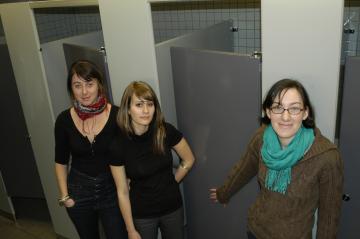Student video project brings "ambient violence" into focus
- Tara Sharpe

How can a campus community continue to build an inclusive and respectful campus if some of its building blocks are marred by hateful ‘graffiti’? This was the question posed by several University of Victoria undergraduate students after they found messages of hate and violence scratched on a classroom cabinet last summer.
The discovery of these messages in the very classroom where a third-year women’s studies research course taught by professor Dr. Jo-Anne Lee was being held brought their theoretical coursework into real and instant focus. It sparked the 20 students to search the UVic campus for other evidence of offensive “graffiti”—the students question whether it should even be considered “graffiti” as there is no sense of art in the hate messages—which they found hidden behind washroom doors and other places on campus. They consequently chose to use the term “ambient violence” to reflect the pervasive and background nature of such messages and they took photographs of what they found.
A smaller group of eight students in a follow-up course then produced a 10-minute video, Graffiti or Ambient Violence?, to document these instances and to raise awareness about the impacts of racist, homophobic, sexist and misogynist language on marginalized groups and society as a whole. The group will present their film this summer at the Canadian Women’s Studies Association Conference in Vancouver, with assistance from a small grant received from the BC Government Support for Student Led Research in the Social Policy Field.
During a meeting on March 12, UVic President David Turpin and the president’s advisory committee on equity and human rights issues, the University Human Rights Committee (UHRC), discussed the overall issues and the action it has sparked. Turpin considers the student-led initiative to be a call to action for everyone on campus.
“The real message is that each of us has a responsibility to help create an inclusive environment. We have to act when we see or hear “ambient violence” and work to eliminate it.” Turpin said, “Feeling unwelcome on campus—whether as an international student or a member of a marginalized group—can be one of the most damaging outcomes of this unacceptable behaviour.”
The scrawls captured in the film have already been removed by facilities management staff, and the initiative of the students has galvanized that department and Campus Security Services. It was already standard operating procedure to quickly remove any reported hate messages. Security personnel take a photograph and document every reported instance of ambient violence. Janitorial and other facilities staff are encouraged to report the messages directly to security personnel and, after the incident is documented, act immediately whether by washing off and painting over the offensive scrawl or promptly arranging for a more extensive removal. The systematic record-keeping of each incidence can also serve to capture the effectiveness of campus strategies for inclusion and other educational efforts.
Hate-mongering and property damage are both criminal acts, and the local police have already been involved in investigations on campus.
“In the video and our presentations, we continue to emphasize the many levels where responsibility lies,” says Jenny Shaw, one of the eight filmmakers and a recent anthropology graduate. “We believe it is not just an individual issue but also one that we as a campus community should address through structural programs, dialogue and open discussion.”
Many of UVic’s janitorial staff on the front lines of message removal are themselves from other countries and cultures, adding an onerous and personal element to an already distasteful task. Some of the offensive messages have also targeted certain nationalities, while violent misogynist drawings target women. The issues they represent can’t be erased with just a quick clean-up.
“This is not only a campus issue,” says human rights educator Moussa Magassa of UVic’s Department of Equity and Human Rights. “It is a social and international issue.” March 21 was the UN International Day for the Elimination of Racial Discrimination, and at UVic, days of action are supported by student advocacy groups such as the UVic Pride Collective, the Anti-Violence Project, the Students of Colour Collective, the Women’s Centre, ACCESS UVic! and the Native Students’ Union.
UVic has a new human rights policy, and a Department of Equity and Human Rights. Grace Wong Sneddon is UVic’s diversity advisor to the vice-president academic and provost, who helped to host a Feb. 6 event “Critical Conversations about Diversity.” Participants indicated that they overwhelmingly want a diversity conference next year and more education/panels about race and racism.
On Feb. 27, during Anti-Oppression Week on campus, an ambient violence panel led by members of the University Human Rights Committee presented a discussion on the video’s content, current action and next steps.
To maintain awareness about the impact of ambient violence, conversation and action must be ongoing. Anyone who finds scrawls or images with a sexist, homophobic or racist message on campus should contact Campus Security Services 24-hour emergency number at 721-7599 so that the messages can be recorded and removed promptly.

